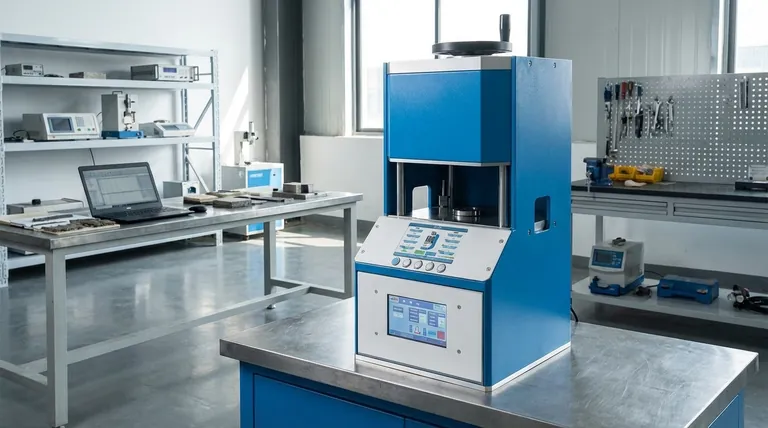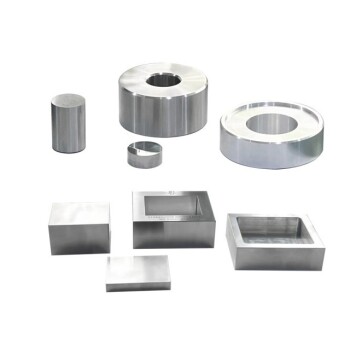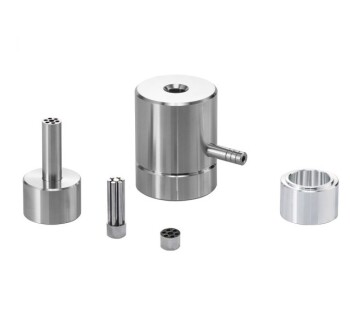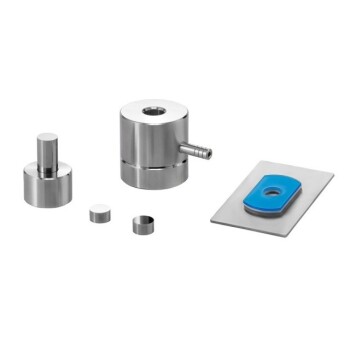At its core, a heated hydraulic press is a machine that combines immense, controllable force with precise, high temperatures. It uses a liquid-based hydraulic system to generate significant pressure, which is applied through heated plates, known as platens, to compress, bond, cure, or shape a wide variety of materials. This dual action makes it essential for manufacturing processes involving composites, plastics, rubber, and laminates.
To effectively manipulate modern materials, simply applying force is often insufficient. A heated hydraulic press addresses this by integrating two distinct systems: a hydraulic system that amplifies force according to Pascal's principle, and a thermal system that applies controlled heat to transform the material's properties during compression.

The Foundational Principle: How Force is Amplified
The power of any hydraulic press comes from a simple yet profound concept known as Pascal's Principle.
The Law of Fluid Pressure
This principle states that pressure applied to an enclosed fluid is transmitted undiminished to every portion of the fluid and the walls of the containing vessel.
In a press, a small amount of force is applied to a small piston, which pressurizes the hydraulic fluid. This pressure travels through the system and acts on a much larger piston. Because the surface area of the larger piston is many times greater, the initial force is multiplied proportionally, generating the massive tonnage required for industrial work.
Deconstructing the Core Systems
A heated hydraulic press is best understood as two primary systems working in concert within a single mainframe: the hydraulic system that creates the force and the thermal system that delivers the heat.
The Hydraulic System: The Source of Power
This system is the "muscle" of the machine, responsible for generating and controlling the pressing force.
Pump and Motor
The electric motor drives a hydraulic pump. The pump does not create pressure itself; it generates a flow of hydraulic fluid. Pressure is built when this flow meets resistance, such as when the press ram meets the workpiece.
Hydraulic Fluid and Reservoir
A reservoir holds the hydraulic fluid, typically a specialized oil. This fluid is the lifeblood of the system, acting as the medium that transmits energy from the pump to the cylinder.
Cylinder and Ram
The cylinder is a heavy-duty tube containing a piston, often called the ram. As pressurized fluid is forced into the cylinder, it pushes the ram out with immense force, driving the platen down onto the material.
Control Valves
Valves are the control interface of the hydraulic system. They direct the flow of fluid, allowing the operator to start, stop, and reverse the ram's movement and, most importantly, to precisely regulate the amount of pressure applied.
The Thermal System: Applying Precise Heat
This system is what separates a heated press from a standard one. It is integrated directly into the platens—the surfaces that make contact with the material.
Heated Platens
Platens are the large, flat, heavy steel or aluminum plates that press the workpiece. In a heated press, these platens are engineered with internal channels or holes to accommodate heating elements.
Heating Elements
The heat is most commonly generated by electric cartridge heaters inserted directly into the platens. These robust heaters can generate high, evenly distributed temperatures required for processes like curing or lamination.
Temperature Controllers and Sensors
To ensure accuracy, thermocouples or other temperature sensors are embedded within the platens. These sensors send real-time data to a temperature control unit, which cycles the heating elements on and off to maintain the exact temperature set by the operator.
Understanding the Trade-offs and Pitfalls
While incredibly versatile, a heated hydraulic press has specific characteristics and potential challenges that are important to understand.
Complexity and Maintenance
You are managing two distinct systems. The hydraulic side is prone to leaks if seals degrade, while the thermal side involves electrical components, wiring, and sensors that can fail over time. Routine maintenance is critical for both.
Speed vs. Force
Hydraulic presses offer unparalleled force and control, but they are generally slower than mechanical presses. The ram speed is limited by the volume of fluid the pump can move. This makes them ideal for processes requiring a long "dwell time" under heat and pressure, but less so for rapid stamping operations.
The Importance of Control Parameters
Successful operation depends entirely on the correct combination of three variables: pressure, temperature, and time. An incorrect setting for any of these can lead to delamination, incomplete curing, or damaged parts. The quality of the press's control system is paramount for achieving repeatable results.
Making the Right Choice for Your Application
Selecting or using a heated press effectively means matching its capabilities to your specific process goal.
- If your primary focus is material bonding or curing (e.g., composites, laminates): The precision and uniformity of the thermal system are your most critical factors. Ensure the press offers tight temperature control across the entire platen surface.
- If your primary focus is forming or molding dense materials (e.g., rubber, plastics): The press's tonnage (force capacity) and structural rigidity are key. You need a machine that can apply and sustain high pressure without frame deflection.
- If your primary focus is process repeatability and R&D: A sophisticated control system is non-negotiable. Look for features like pressure ramping, multi-stage temperature profiles, and data logging.
By understanding how these hydraulic and thermal systems work in concert, you can effectively leverage a heated hydraulic press to achieve your specific manufacturing goals.
Summary Table:
| Component/System | Function | Key Features |
|---|---|---|
| Hydraulic System | Generates and controls pressing force | Includes pump, motor, cylinder, ram, and valves for precise pressure application |
| Thermal System | Applies controlled heat during compression | Features heated platens with elements, sensors, and controllers for uniform temperature |
| Main Applications | Used in bonding, curing, forming, and molding | Ideal for composites, plastics, rubber, and laminates with high force and heat requirements |
Ready to enhance your lab's material processing with a reliable heated hydraulic press? KINTEK specializes in lab press machines, including automatic lab presses, isostatic presses, and heated lab presses, designed to deliver precise force and temperature control for applications in composites, plastics, and rubber. Contact us today via our contact form to discuss how our solutions can boost your efficiency and achieve superior results!
Visual Guide

Related Products
- Automatic High Temperature Heated Hydraulic Press Machine with Heated Plates for Lab
- Automatic Heated Hydraulic Press Machine with Hot Plates for Laboratory
- Heated Hydraulic Press Machine with Heated Plates for Vacuum Box Laboratory Hot Press
- Automatic Heated Hydraulic Press Machine with Heated Plates for Laboratory
- Laboratory Manual Heated Hydraulic Press Machine with Hot Plates
People Also Ask
- What role does a heated hydraulic press play in powder compaction? Achieve Precise Material Control for Labs
- How does using a hydraulic hot press at different temperatures affect the final microstructure of a PVDF film? Achieve Perfect Porosity or Density
- Why is a hydraulic heat press critical in research and industry? Unlock Precision for Superior Results
- How are heated hydraulic presses applied in the electronics and energy sectors? Unlock Precision Manufacturing for High-Tech Components
- What is the core function of a heated hydraulic press? Achieve High-Density Solid-State Batteries



















